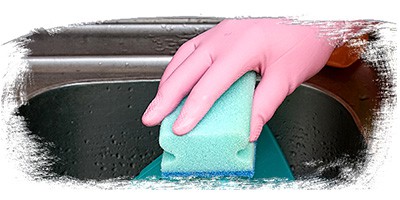There are cleaning products hazards lurking under your sink! Your daily kitchen cleaners may or may not be able to qualify for green cleaning status (heck, some of them are downright toxic and absolutely NOT green cleaning products!)
Do you use traditional cleaners or do you have green cleaning products? When you critically evaluate what is under your kitchen sink, using natural green home cleaning products becomes a must if you you want to:
- Ensure safety of the products to your loved ones, especially your babies, kids and pets.
- Protect the environment by paying attention to the source of the ingredients (are they bio-based), biodegradability of the products, and the packaging used.
- Reduce the cost of cleaning. Fortunately the cost of green cleaning products have decreased, especially when you consider the life cycle analysis of the product.
 We want to help you have a safer and greener lifestyle. Look under your kitchen sink. Some very common products that people use all of the time may not be able to be considered as qualifying for green sustainability.
We want to help you have a safer and greener lifestyle. Look under your kitchen sink. Some very common products that people use all of the time may not be able to be considered as qualifying for green sustainability.
For instance Clorox Wipes. How many do we use? What do we do after we are finished with them? These single use cloths are just increasing our waste and clogging up our landfills!
The primary reason we use Clorox Wipes is because of their disinfecting qualities. However, read the label. To be effective, it says you need to use enough wipes to keep the surface WET (not damp, but wet) for FOUR minutes! If you just wipe the surface and walk away as we tend to do, it is totally ineffective. Disinfectants do require what is known as dwell time. Another common disinfectant is Formula 409. If you read the back of that label, it says it must be wet and sit for a full TEN minutes before it is effective. So in our tradition of spray and wipe when we clean, is important to realize that we are not disinfecting anything, despite our intentions.
Windex is something else that is common everywhere we clean. Unfortunately many contain ammonia for a streak free clean. Others may not have ammonia, but we do not know what they have because have ingredients are not listed. Household cleaners do not have a legal obligation to list ingredients on the labels. If you obtain the Material Safety Data Sheet (MSDS) from the manufacturer, you can find more information about the product. For instance, Windex contains ethylene glycol . This is antifreeze! (More can be found at Green but Toxic | Are Your Green Cleaning Products Toxic or Safe)
Other things that are pretty scary on the back of these labels is what kind of health hazards they are talking about or what kinds of labels they have. This one has caution in a tiny font size on the back of the entire label. It also says eye irritation, as well as first aid requirements, and that you have to wash with soap and water thoroughly after handling … Wait a minute I thought we were cleaning here!
A product under any kitchen sink is hand dish soap. Is yours antimicrobial? If so, it likely contains triclosan, an antibacterial and antifungal chemical found in soap. Is Antimicrobial Hand Soap Safe or Do I Seek Green Cleaning Products ? Triclosan is an endocrine disruptor and accumulates in our body and stored in our fat. Even worst, it will produce chloroform or chorine byproducts with exposure to water … in 1 minute of hot water.
To be eco friendly and promote green sustainability, select products that are renewable, bio-based, and natural. So for instance, the ingredients in many of the products from Green Cleaning Products are listed as enzymes, plant based surfactants and natural scents and dyes. Whereas these products have petrochemical based as well as scents and fragrances that are also very toxic to us.
If you would like find out what we feel are great (healthy) cleaning products or find out how affordable green cleaning products have become, shop our green cleaning store today!
Leave a Reply